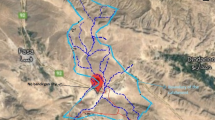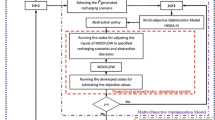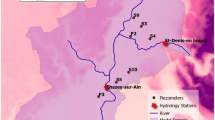Abstract
Aquifer recharge rates and patterns are often uncertain, especially in arid areas due to sporadic and erratic rainfall. Therefore, determining the optimal groundwater abstraction using classical approaches such as Monte Carlo Simulation (MCS) requires a large number of groundwater simulations and exorbitant computational efforts. The problem becomes even more complex and time consuming for regional coastal aquifers whose domains must be discretized using high-resolution meshes. In fact, even fast evolutionary multi-objective optimization techniques generally require a large number of simulations to determine the Pareto-front among the objectives. This study explores the performance of a Decision Tree (DT) approach for the generation of the Pareto optimal solutions of groundwater extraction. This paper applies the DTs for the optimal management of the Al-Khoud coastal aquifer in Oman. The learning process of the developed DT-based model uses the output of a numerical simulation model to assess the aquifer response based on different abstraction policies. The trained DT network then utilizes the NSGA-II to determine the Pareto-optimal solutions. The simulation show that the general flux pattern in the study area is toward the sea and the hydraulic head following a similar pattern in both best and worst recharging scenarios downstream of the studied recharging dam. Statistical tests showed a good correlation between the DT-based and simulation-based results and demonstrate the capability of the DT approach to obtain high-quality solutions by incorporating a large number of recharge scenarios. Moreover, the required runtime of the DT-based approach is extremely low (5 min) compared to that of the simulation-based method (several days). This means that including additional Monte-Carlo simulations can be readily done in few minutes using the obtained DTs, instead of the long computational time needed by the simulation-based approach.





Similar content being viewed by others
References
Abolfathi S, Yeganeh-Bakhtiary A, Hamze-Ziabari SM, Borzooei S (2016) Wave runup prediction using M5′ model tree algorithm. Ocean Eng 112:76–81
Al-Lawati A (1997) Groundwater recharge in the upper catchment of wadi Samail – Sultanate of Oman. MSc Thesis, Flinders University of South Australia, Australia
Ataie-Ashtiani B, Ketabchi H (2010) Elitist continuous ant colony optimization algorithm for optimal Management of Coastal Aquifers. Water Resour Manag 25(1):165–190
Balouchi B, Nikoo MR, Adamowski J (2015) Development of expert systems for the prediction of scour depth under live-bed conditions at river confluences: application of different types of ANNs and the M5P model tree. Appl Soft Comput 34:51–59
Bassi N (2016) Groundwater depletion in India: potential of alternative approaches and policy instruments. Indian water policy at the crossroads: resources, technology and reforms. Springer, pp 35–48
Bazargan-Lari MR, Kerachian R, Mansoori A (2009) A conflict-resolution model for the conjunctive use of surface and groundwater resources that considers water-quality issues: a case study. Environ Manag 43(3):470–482
Deepa C, SathiyaKumari K, Sudha VP (2010) Prediction of the compressive strength of high performance concrete mix using tree based modeling. Int J Comput Appl 6(5):18–24
Dentoni M, Deidda R, Paniconi C, Qahman K, Lecca G (2014) A simulation/optimization study to assess seawater intrusion management strategies for the Gaza strip coastal aquifer (Palestine). Hydrogeol J 23(2):249–264
Ebrahim GY, Jonoski A, Al-Maktoumi A, Ahmed M, Mynett A (2015) Simulation-optimization approach for evaluating the feasibility of managed aquifer recharge in the Samail lower catchment, Oman. J Water Resour Plan Manag 142(2):1–16
Faysse N, El Amrani M, El Aydi S, Lahlou A (2012) Formulation and implementation of policies to deal with groundwater overuse in Morocco: which supporting coalitions? Irrig Drain 61(S1):126–134
Freeze RA, Cherry JA (1979) Groundwater. Prentice-Hall, Inc, Englewood Cliffs
Ghahreman N, Sameti M (2014) Comparison of M5 model tree and artificial neural network for estimating potential evapotranspiration in semi-arid climates. Desert 19(1):75–81
Harbaugh AW, Banta ER, Hill MC, McDonald MG (2000) MODFLOW-2000, the US geological survey modular ground-water model: user guide to modularization concepts and the ground-water flow process, VA, USA
Hoogesteger J, Wester P (2015) Intensive groundwater use and (in)equity: processes and governance challenges. Environ Sci Pol 51:117–124
Hussain MS, Javadi AA, Ahangar-Asr A, Farmani R (2015) A surrogate model for simulation–optimization of aquifer systems subjected to seawater intrusion. J Hydrol 523:542–554
Javadi A, Hussain M, Sherif M, Farmani R (2015) Multi-objective optimization of different management scenarios to control seawater intrusion in coastal aquifers. Water Resour Manag 29(6):1843–1857
Jiekang W, Jianquan Z, Guotong C, Hongliang Z (2008) A hybrid method for optimal scheduling of short-term electric power generation of cascaded hydroelectric plants based on particle swarm optimization and chance-constrained programming. IEEE Trans Power Syst 23(4):1570–1579
Ju Q, Hao Z, Yu Z, Chen X, She C (2011) Study of the model of spring flow forecast--a case of the Xiaonanhai spring Catchement. Journal of Sichuan University: Engineering Science Edition 43(1):77–82
Jung N-C, Popescu I, Kelderman P, Solomatine DP, Price RK (2010) Application of model trees and other machine learning techniques for algal growth prediction in Yongdam reservoir, Republic of Korea. J Hydroinf 12(3):262–274
Karamouz M, Tabari MR, Kerachian R (2007) Application of genetic algorithms and artificial neural networks in conjunctive use of surface and groundwater resources. Water Int 32(1):163–176
Khan SA, See L (2006) Rainfall-runoff modelling using data driven and statistical methods. 2006 international conference on advances in space technologies
Kourakos G, Mantoglou A (2011) Simulation and multi-objective management of coastal aquifers in semi-arid regions. Water Resour Manag 25(4):1063–1074
Kumar SA, Vijayalakshmi M (2012) A naive based approach of model pruned trees on learner's response. International Journal of Modern Education and Computer Science 4(9):52
Milinković S, Maksimović M (2013) Using decision tree classifier for analyzing students’ activities. JITA-Journal of Information Technology and Applications (Banja Luka)-APEIRON 6(2)
Nikoo MR, Karimi A, Kerachian R, Poorsepahy-Samian H, Daneshmand F (2013) Rules for optimal operation of reservoir-river-groundwater systems considering water quality targets: application of M5P model. Water Resour Manag 27(8):2771–2784
Onyari E, Ilunga F (2013) Application of MLP neural network and M5P model tree in predicting streamflow: a case study of Luvuvhu catchment, South Africa. International Journal of Innovation, Management and Technology 4(1):11
Quinlan JR (1992) Learning with continuous classes. 5th Australian joint conference on artificial intelligence, Singapore
Roy T, Schütze N, Grundmann J, Brettschneider M, Jain A (2016) Optimal groundwater management using state-space surrogate models: a case study for an arid coastal region. J Hydroinf. doi:10.2166/hydro.2016.086
Ruan Y-X, Lin H-T, Tsai M-F (2014) Improving ranking performance with cost-sensitive ordinal classification via regression. Inf Retr 17(1):1–20
Safavi HR, Darzi F, Mariño MA (2009) Simulation-optimization modeling of conjunctive use of surface water and groundwater. Water Resour Manag 24(10):1965–1988
Yeh W-G (2015) Review: optimization methods for groundwater modeling and management. Hydrogeol J 23(6):1051–1065
Zekri S, Triki C, Al-Maktoumi A, Bazargan-Lari MR (2015) An optimization-simulation approach for groundwater abstraction under recharge uncertainty. Water Resour Manag 29(10):3681–3695
Acknowledgements
This research was partially supported by internal grant IG/ENG/MIED/14/01 from Sultan Qaboos University and by TRC grant number RC/AGR/ECON/12/01. This financial support is gratefully acknowledged.
Author information
Authors and Affiliations
Corresponding author
Rights and permissions
About this article
Cite this article
Triki, C., Zekri, S., Al-Maktoumi, A. et al. An Artificial Intelligence Approach for the Stochastic Management of Coastal Aquifers. Water Resour Manage 31, 4925–4939 (2017). https://doi.org/10.1007/s11269-017-1786-3
Received:
Accepted:
Published:
Issue Date:
DOI: https://doi.org/10.1007/s11269-017-1786-3




